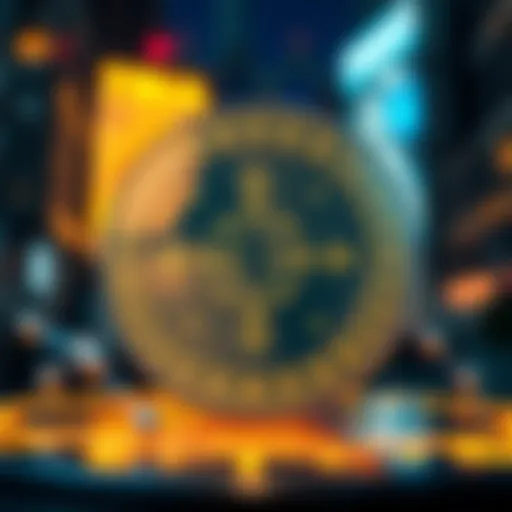Dynamics of Digital Artwork Auctions in the NFT Era
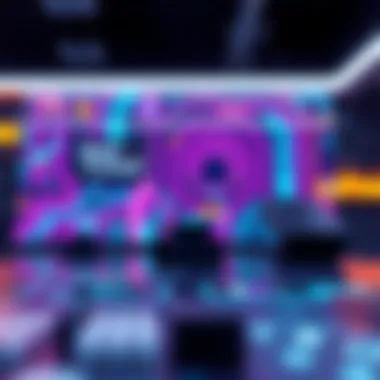

Intro
In recent years, digital art auctions have emerged as a fascinating sector that melds creativity with cutting-edge technology. As more artists embrace the digital canvas, the role of cryptocurrencies and blockchain technology becomes ever more pivotal. This article seeks to investigate the forward momentum of digital artwork auctions, focusing on how they are reshaping the artistic landscape, influencing investment trends, and revolutionizing ownership models. Across the board, the dialogue about digital art is not just about aesthetics; it’s about economics, opportunity, and the future of art itself.
Digital art can take many forms—from static images and animated GIFs to dynamic multimedia compositions. The advent of non-fungible tokens, or NFTs, has fundamentally altered how artists sell their work. It opens the gates to a realm where ownership is not simply a transaction; it's a unique digital experience. People can now own a piece of artwork, and more than that, they can trace its provenance with ease.
Thus, understanding the intricate dance between art, technology, and finance is paramount. Enthusiasts and investors alike will find invaluable insights that promise not just to enlighten but also to evolve their comprehension of modern art markets.
Trends in Cryptocurrency
Digital artwork auctions are closely intertwined with the rapid developments in the cryptocurrency landscape. Here, we will delve into some significant trends that are shaping the future of this domain.
Current Market Trends
As of late, the interest in cryptocurrency has skyrocketed, making waves across various industries. Art auctions have not been left behind. The rise of platforms like OpenSea and Rarible has enabled artists to monetize their work directly, sidestepping traditional galleries.
Key Points:
- Digital artwork sold for astounding sums. For instance, digital artist Beeple's $69 million sale debuted a new era for digital art.
- Traditional investors are also tapping into this market, recognizing the potential returns that digital art could hold.
- The integration of cryptocurrencies allows for seamless transactions across borders, facilitating a global market.
Emerging Technologies in Blockchain
Blockchain technology isn’t just a digital ledger; it’s a transformative tool in the art world. Smart contracts are becoming the norm, allowing creators to set specific terms for sales and resale.
Blockchain can create untangling thread of ownership, securing the artist's claim over the artwork, thus ensuring fair compensation.
Key technologies to keep an eye on:
- NFT platforms such as Foundation and SuperRare, which not only sell art but foster community.
- Fractional ownership models that let multiple investors co-own high-value pieces, democratizing access.
Investment Strategies
As with any new market, understanding the landscape is pivotal for making sound investments in digital artwork. The fluidity and volatility of this sector call for calculated strategies.
Long-term vs. Short-term Investing
Investors face a choice: take a long-term approach or seize short-term opportunities.
- Long-term investors generally seek established or emerging artists whose work appears poised for appreciation.
- Short-term investors might dive into trending pieces or artworks generating buzz in the community, hoping for rapid returns.
Risk Management Techniques
Investing in digital art is not without its risks.
- Diversification: Just as in traditional assets, don’t put all your eggs in one basket. Consider a mix of artists and styles.
- Staying Informed: Liquid markets can be volatile, so keeping abreast of market trends is crucial.
- Market Research: Understand an artist's background and their perceived value in the community before investing.
In wrapping these insights, potential investors can align their strategies with sound principles, maximizing the potential rewards while mitigating risks. The digital art auction world is an evolving narrative, impacting not just art but the very notion of ownership and investment in the 21st century. Keep an eye on emerging trends, familiarize yourself with the technology, and always proceed with due diligence.
The Concept of Digital Artwork
The primary focus of this discussion revolves around digital artwork, a vibrant field that is inherently intertwined with technology. Its importance is underscored by the rapid growth in digital ownership and the transformative nature of how art is created, shared, and sold. Digital artwork not only challenges traditional perceptions of art but also breaks down barriers within the art community. Understanding this concept is crucial, especially as digital platforms increasingly become the go-to venues for artists and collectors alike.
Defining Digital Art
Digital art is essentially any art form that is created, stored, or displayed using digital technology. This encompasses a broad range of methods, including digital painting, photography, and graphics. It’s an umbrella term that captures diverse practices and mediums, showcasing the innovative possibilities of art in the 21st century. One might argue that digital art functions like an infinite canvas, where artists are no longer restricted by tangible materials.
Historical Context
To truly appreciate digital art, one must look back at its evolution. The 1960s marked the inception of computer-generated art, often dismissed as a novelty. Fast forward to today, technology has integrated itself into every facet of our lives, and art is no exception. The rise of personal computers and creative software democratized artistic expression, enabling anyone with access to technology to create. With the advent of the Internet in the 1990s, digital art gained a substantial audience, allowing creators to showcase their work globally.
Types of Digital Artwork
In today’s expansive digital milieu, various forms of artwork reside, each bringing unique merits to the table.
Static Images
Static images are perhaps the most straightforward form of digital artwork, consisting of still visuals created using software like Adobe Photoshop or Procreate. This medium connects deeply with many artists because it allows them to craft detailed images without the constraints of physical materials. A notable aspect of static images is their ability to be easily shared online, making them popular among contemporary artists. However, the downside is that they lack interactivity, which can limit engagement from viewers.


Animations
Animations represent a significant leap in digital storytelling. By combining images and sound, they convey narratives in dynamic ways that still images cannot achieve. Artists lean towards animations because they can evoke emotions and capture attention more effectively. Employing tools like Blender or After Effects, creators craft works that are visually arresting and immersive. Nevertheless, animations require more resources and time to produce than static images, which can be a hurdle for some.
Interactive Installations
Interactive installations represent the intersection of art and technology, inviting participation from the audience. These works often leverage advanced technology, such as augmented reality or motion sensors, allowing viewers to engage with the artwork directly. This level of interactivity creates a more personal experience and encourages deeper discussions about the pieces. However, they can be technically complex and require a clear understanding of both art and technology, presenting a barrier for some artists who might not possess the required skills.
"Digital artwork is where creativity meets technology, transcending traditional boundaries of art creation and appreciation."
As such, exploring these different types of digital artwork reveals the vast potential and ongoing evolution within the art community. Each form has its own set of characteristics, advantages, and limitations that contribute uniquely to the digital art landscape.
Understanding Auctions
The world of auctions has been around for centuries, serving as a unique method of buying and selling goods, art, and collectibles, among other things. In the landscape of digital artwork, understanding auctions becomes crucial as it sheds light on how value is assigned and transactions are made within this innovative market. Digital artwork auctions bridge the traditional and the new, intertwining established practices with modern technologies like blockchain and NFTs, leading to an entirely new set of dynamics.
The significance of grasping the nuances of auctions rests on several key elements:
- Transparency: Auctions foster a level of transparency in pricing and ownership that benefits both buyers and sellers. Each bid made is visible and can provide insights into the perceived worth of the artwork.
- Competition: The competitive nature of auctions can drive prices up as interested parties participate in a bidding war, thus potentially augmenting the value of a piece beyond initial expectations.
- Engagement and Excitement: By design, auctions create a sense of urgency and excitement. This heightened engagement can translate into increased value as buyers are often more willing to pay more when they feel an emotional connection to the piece at stake.
- Broader Audience Reach: Digital platforms allow auctions to attract a more diverse and global audience, bypassing geographical limitations that traditional auctions often faced. This expanded reach can draw in higher bids and varied perspectives on value.
Given these elements, it’s clear that understanding auctions is not merely about knowing how to place a bid but also about comprehending the intricate market dynamics at play. Auctions are an essential aspect of the digital art auction space, influencing how artists, collectors, and investors interact with the art world.
The Mechanics of Auctions
At its core, an auction operates on a straightforward principle: pairing willing buyers and sellers. Yet, the actual mechanics can be quite intricate, especially in the context of digital artwork. Here’s how it all works:
First, an artist or seller submits a digital piece to an auction platform. This can often involve uploading the artwork alongside pertinent details such as its dimensions, medium, and reserve price—the minimum amount the seller is willing to accept. Once the auction goes live, potential buyers can start placing their bids.
The auction typically has a set timeframe during which bids are accepted. Bidders can either participate actively, raising their bids in real-time, or place proxy bids, where the system bids on their behalf up to a predetermined limit. This feature allows for strategic maneuvering, especially when aiming for a piece with high demand.
Additionally, the auction platform usually imposes certain rules, such as bidding increments and time limits, adding layers to the bidding strategy. At the conclusion of the auction, the highest bidder secures ownership of the piece, often facilitated by a blockchain transaction that ensures a clear transfer of ownership.
Online vs. Traditional Auctions
The shift from traditional to online auctions has been nothing short of revolutionary, especially in the realm of digital artwork. While both formats serve the primary purpose of buying and selling, their operational distinctions are profound.
- Accessibility: Online auctions provide ease of access for participants around the globe. Unlike traditional auctions, which may occur at physical locations, online platforms allow anyone with an internet connection to join in, significantly widening the pool of potential buyers.
- Anonymity: Bidders can participate without revealing their identities until the transaction. This anonymity can lead to more competitive bidding as participants may feel emboldened to place higher bids without the fear of social perception.
- Technological Integration: The use of blockchain technology in online auctions not only ensures the integrity of the bidding process but also creates a secure ledger for transactions. This contrasts with traditional methods where records may be prone to errors or manipulations.
- Fees and Commissions: Online auction houses often charge different fees compared to their traditional counterparts. These can include listing fees, buyer premiums, and transaction fees, which can impact final pricing strategies for both sellers and buyers.
Both auction forms have their place in the market; however, the convenience and reach of online auctions make them an appealing choice in today's digital landscape. As digital artwork continues to grow in popularity, the understanding of auction dynamics is essential for participants in this evolving marketplace.
The Emergence of Digital Artwork Auctions
The rise of digital artwork auctions signifies a seismic shift in the landscape of art commerce. These auctions have transformed how creators, collectors, and investors engage with art, largely due to the integration of innovative technologies like blockchain and NFTs. As we delve into this section, it is essential to consider how these elements not only reshape ownership but also how they challenge traditional notions of value and authenticity in the art world.
The Role of Blockchain Technology
Blockchain technology serves as the backbone of digital artwork auctions. Its decentralized nature provides a transparent and secure framework for transactions. Each piece of digital art can be tracked on the blockchain, establishing a verifiable history of ownership. This characteristic not only enhances trust among buyers but also mitigates risks of fraud and forgery, which have long plagued the traditional art market.
Moreover, the immutability of blockchain records means that once a transaction is recorded, it cannot be altered. This quality makes it a powerful tool for artists, allowing them to maintain control over their creations even after the sale. As artists sell their work, they can embed smart contracts that dictate how future sales of their artwork will benefit them, a feature not commonly available in traditional auctions.
NFTs and Their Impact
Ownership Verification
Ownership verification through NFTs (Non-Fungible Tokens) represents a revolutionary approach to art provenance. When an artist mints a digital piece as an NFT, they create a unique token that is distinct and tethered to that particular artwork. This process ensures that buyers are purchasing an original piece rather than a copy. NFTs symbolize authentic ownership, making them a sought-after choice for buyers looking to invest in digital art.
However, there's a downside. The NFT market's volatility has raised questions about stability and long-term value. While some artworks soar in value, others may plummet, making it crucial for buyers to conduct thorough research before diving into this newer form of art investment. Moreover, the environmental impact of blockchain operations has sparked debates, as the energy consumption for minting NFTs can be significant.
Market Trends
Understanding market trends is imperative for grasping the current dynamics in digital artwork auctions. The digital art space has seen rapid growth, with increasing participation from investors and collectors. This influx not only pushes up prices but also showcases evolving consumer preferences. For instance, younger generations favor digital art forms, attracted by their accessibility and the innovative possibilities they offer.
Key characteristic of current market trends is the rising interest in utility-driven NFTs. These tokens often come with perks such as exclusive access to future artworks or experiences related to the artist. Collectors are keen on finding value beyond mere aesthetic pleasure; they want a connection or an experience.
Nevertheless, while the market experiences dizzying highs, a more cautious approach might be wise for potential investors. The landscape remains unpredictable, with trends that can shift overnight. Keeping an eye on current developments and reports from sources like CoinDesk can provide insights into fluctuations and emerging opportunities.
"The intersection of technology and creativity in digital artwork auctions is not simply a trend; it’s a recalibration of how value is perceived in art today."
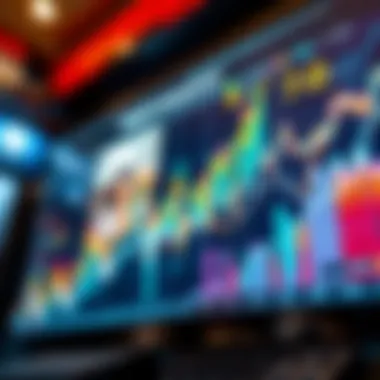
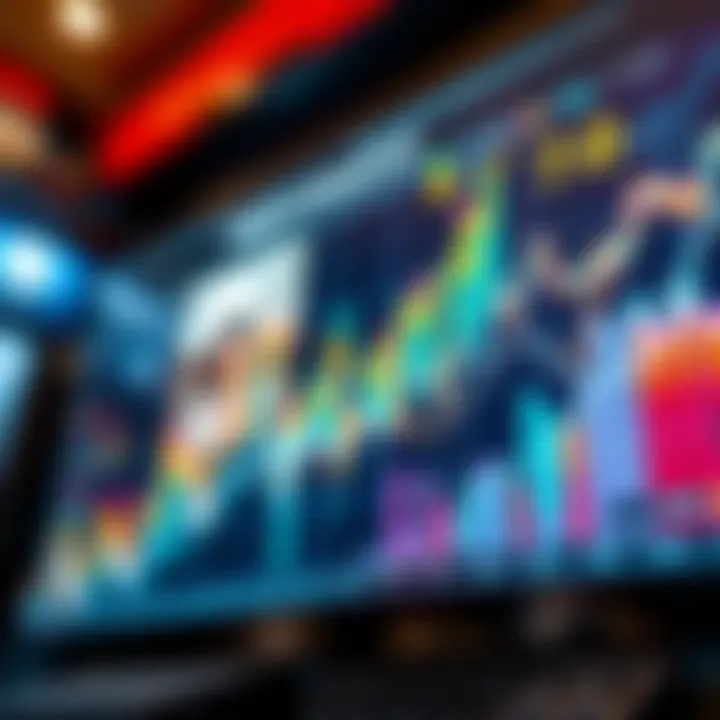
This section aims to shed light on the emergence of digital artwork auctions, highlighting significant changes brought by blockchain technology and NFTs. Understanding these elements is crucial for anyone looking to navigate this new frontier successfully.
Key Players in the Digital Artwork Auction Space
In the world of digital artwork auctions, understanding the key players is crucial to grasping the broader dynamics at play. This realm isn't just about the pieces being sold; it's also about the entities and individuals that drive the market forward. The interconnectedness of platforms, artists, investors, and collectors shapes the entire landscape of digital art. Each player plays a vital role, presenting benefits and considerations that can impact auction outcomes and market trends.
Major Platforms
When it comes to digital artwork auctions, the platforms are the lifeblood of the ecosystem. Major platforms such as OpenSea, Rarible, and Foundation serve as marketplaces where creators and buyers converge. Each platform has its unique features, attracting different segments of the audience.
- OpenSea: Known for its extensive range of digital assets, OpenSea allows users to create, buy, and sell various types of digital art and NFTs. Its user-friendly interface makes it a favorite among newcomers and seasoned collectors alike.
- Rarible: This platform emphasizes community engagement and decentralization. Users can vote on platform developments through governance tokens, creating a sense of ownership in the ecosystem.
- Foundation: Unlike the others, Foundation focuses on artist collaboration and exclusive drops. Artists can invite others to participate in auctions, fostering a sense of community among creators.
These platforms not only provide the framework for transactions but also set the tone for how digital artwork is perceived and valued in the market. Their varied approaches to fees, community involvement, and auction mechanics play a crucial role in shaping buyer behavior.
Artists and Creators
Artists and creators stand at the forefront of digital artwork auctions. They are the visionaries who produce the unique works that attract attention and demand in the market. Each artist brings their style and narrative to the digital canvas, which can deeply resonate with collectors.
However, while the allure of digital art can lead to lucrative returns, artists face various challenges. These include:
- Visibility: With a burgeoning number of artists entering the digital space, standing out from the crowd can be daunting. This visibility game compels artists to engage actively with their audience on social media and other platforms.
- Pricing: Determining the right price for their work can be tricky. Artists need to balance their worth with market trends, which can fluctuate wildly.
- Copyright and Royalties: As digital art evolves, so too does the debate around ownership. Artists must navigate copyright issues and ensure they're compensated fairly for their work.
In this burgeoning ecosystem, a successful artist not only thrives on their creativity but also on their ability to market themselves and understand the evolving landscape of digital ownership.
Investors and Collectors
Investors and collectors play a pivotal role in the market dynamics of digital artwork auctions. The influx of capital and interest from this demographic has accelerated the growth of the sector. Understanding their motivations and behaviors helps illuminate the trends currently shaping the marketplace.
- Understanding Value: Investors often lean on various metrics to determine potential investment returns. They may analyze previous sales data, trends in consumer preferences, and even the artist's social media following.
- Hesitance and Market Volatility: The digital art market isn't without its ups and downs. Investors run the risk of being caught in a bidding war that inflates prices or purchasing art that may not retain its initial value. The rapid pace of technological advancements means staying informed is critical.
- Community Engagement: Many collectors not only view their acquisitions as investment opportunities but also as ways to support artists and contribute to the wider art community. This engagement often manifests in sharing their collections, attending webinars, or participating in discussions online.
As the market evolves, so do the strategies employed by investors and collectors, making their ongoing involvement crucial in shaping the digital artwork auction landscape.
"Understanding your role in the digital art ecosystem helps navigate its complexities. Whether a platform, artist, or investor, every player contributes to an intricate web of interactions that define this emerging market."
These key players, with their distinct roles and perspectives, paint a comprehensive picture of the dynamics involved in digital artwork auctions. Their interactions and strategies not only define current trends but also lay the groundwork for the future of digital art.
Market Trends in Digital Art Auctions
Understanding market trends in digital art auctions is essential for anyone involved in this burgeoning field. From emerging technologies to shifting consumer preferences, these trends shape how art is bought, sold, and appreciated in the digital realm. In a time where virtual assets are gaining traction, keeping an eye on these market movements can provide invaluable insights for traders, investors, and art enthusiasts alike.
Sales Statistics
Sales statistics in digital art auctions reveal a wealth of information about the state of the market. In recent years, sales volume has surged dramatically. According to recent reports, the global NFT art market reached over $2 billion in sales in just the first quarter of 2021. This marked a staggering increase from the previous year, showcasing not only consumer interest but also significant investment in digital pieces. The statistics also point to a growing diversification in the types of art being sold. For instance, while profile picture NFTs were once dominant, artists are now experimenting with various formats such as 3D models and interactive pieces.
In terms of platforms, websites like OpenSea and Rarible dominate the scene, facilitating millions worth of transactions. Moreover, auction houses like Sotheby's and Christie's have begun embracing this trend, hosting high-profile auctions that attract both seasoned collectors and curious newcomers. This variety in auction venues means that statistics can be reflective of differing market segments, demonstrating that buyers are not a one-size-fits-all group.
"The entry of traditional auction houses into the digital realm is not merely a trend; it's a seismic shift in how art is perceived and valued."
Tendencies in Consumer Preferences
As the market evolves, so do the preferences of consumers participating in digital artwork auctions. Today’s collectors are not just interested in aesthetics; they also seek a sense of community and utility surrounding their purchases. For instance, buyers often gravitate toward unique pieces that come with a variety of perks, like access to exclusive events or additional digital content. This shift toward added value illustrates a deeper engagement with art that transcends pure visual appeal.
Another notable tendency is the growing interest in sustainability and ethics, particularly among younger collectors. Many consumers express a strong desire to support artists whose works adhere to eco-friendly standards or represent marginalized voices. This reflects a larger societal trend where conscious consumerism is becoming the norm rather than the exception.
On the technology side, ease of use is a critical factor. Buyers are flocking to platforms that offer intuitive interfaces and seamless transactions, often looking for those that accept payment in cryptocurrencies.
Understanding these trends is crucial not just for artists and collectors but also for investors who aim to tap into the pulse of an ever-changing market. By staying informed about the sales statistics and consumer preferences, all participants in the digital art auction landscape can make more informed decisions, fostering a richer ecosystem for creators and collectors alike.
Challenges Faced in Digital Artwork Auctions
In the swiftly evolving domain of digital artwork auctions, there exists a concoction of challenges that stakeholders must navigate. Understanding these hurdles is crucial for artists, collectors, and investors alike. As the market grows, so too do the complications informing its dynamics. This segment will dissect the pressing issues impacting digital art auctions, focusing on market volatility, copyright concerns, and environmental implications.
Market Volatility
Market volatility is perhaps the most palpable challenge in the realm of digital artwork auctions. Like a seesaw, the prices of digital art can swing dramatically over a short period. Speculators often exacerbate this fluctuation, buying low and flipping high, causing prices to skyrocket and plummet with little warning. In some instances, a highly publicized sale may drive up the prices of similar works, leading to inflated valuations that fail to hold water.
For artists and collectors, this volatility can be a double-edged sword. On one hand, there exists potential for profiting immensely; on the other, the risk of losing significant value on an asset cannot be ignored. The lack of historical data compared to traditional art makes it all the more challenging to predict market behavior.

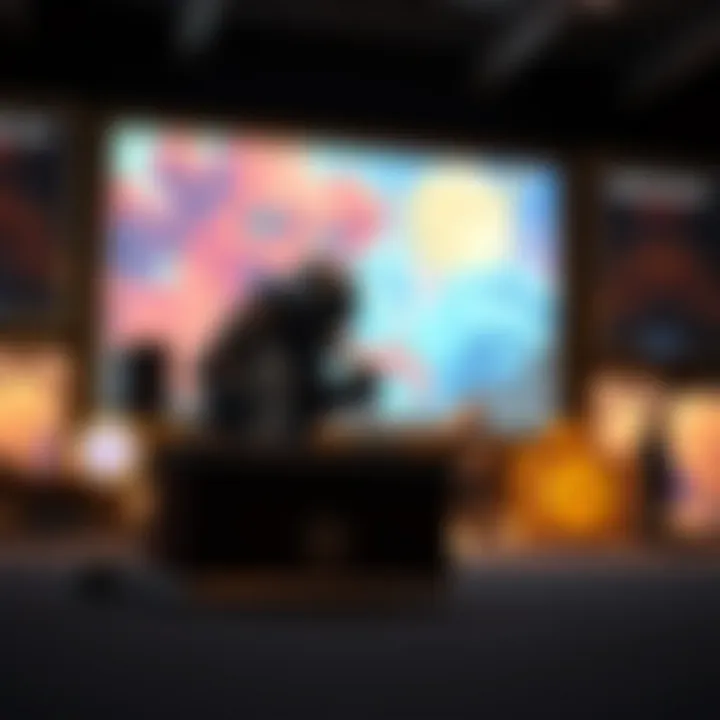
Some strategies can be employed to mitigate potential losses:
- Diversification: Engaging in a variety of artworks instead of putting all eggs in one basket.
- Diligent Research: Staying informed about market trends and artists' movements can help avoid impulsive decisions.
- Setting Limits: Understanding personal thresholds for investment can prevent emotional decisions in heated bidding environments.
Copyright Issues
Copyright concerns in digital artwork auctions present another layer of complexity. Since digital art can be easily replicated, questions regarding ownership and authenticity arise frequently. The perceived ease of copying digital creations can lead to disputes over who holds the rights to a piece, thereby creating uncertainty for both buyers and artists.
Copyright infringement cases are not uncommon. Artists fear that their work might be sold and profited from without their consent. Many have turned to Non-Fungible Tokens (NFTs) as a method to secure their rights. However, even NFTs aren't foolproof. Just because a digital piece is tied to a token doesn't mean that it is immune to piracy or misuse.
Effective measures for artists to protect their creations include:
- Watermarking: This technique can serve as a deterrent against unauthorized use.
- Legal Consultation: Seeking professional advice can clarify rights and obligations within the auction space.
- Educating Buyers: Providing transparency about ownership rights can cultivate a more informed community.
Environmental Concerns
As awareness of environmental issues rises, the ecological impact of digital artwork auctions is becoming increasingly scrutinized. The energy consumption tied to blockchain transactions, particularly those involving NFTs, is considerable. Critics argue that the carbon footprint associated with minting and trading digital artworks is detrimental to our planet.
Statements from various environmental groups highlight that this energy use is comparable to that of small countries. The debate understandably causes some collectors to reconsider their involvement in the digital art space, weighing their passion against their responsibility to the environment.
To address these concerns, solutions are emerging, including:
- Transitioning to eco-friendly platforms: Some auction houses are introducing greener practices and alternatives.
- Using proof-of-stake systems: Unlike traditional proof-of-work methods, these are often more energy-efficient.
"Environmental sustainability is paramount in any modern business endeavor—digital art auctions are no exception."
The challenges described here are not just obstacles; they are contemplations that can redefine the framework of digital artwork auctions. For investors, traders, and technology enthusiasts, understanding these issues is not just important; it’s vital for making informed decisions in this burgeoning field.
The Future of Digital Artwork Auctions
The trajectory of digital artwork auctions is poised to evolve exponentially in the coming years. With the integration of cutting-edge technologies, alongside an increasing understanding of the buyer's market, many factors hint at a profound transformation. It’s not just the art itself that's changing, but the entire ecosystem surrounding it.
Emphasizing technological advancements remains crucial. Innovations such as augmented reality (AR) and virtual reality (VR) are paving the way for more immersive viewing experiences. Imagine being able to step into a digital gallery from the comfort of your home, interacting with the artwork as if it were hanging on your own wall. This type of engagement isn’t just entertaining; it enhances the perceived value of digital art, attracting both seasoned collectors and new enthusiasts to the marketplace.
Additionally, advancements in blockchain technology promise to increase trust and transparency in the auction process, thereby streamlining transactions and reducing fraud. Sellers could rest assured that their works are secure, while buyers gain confidence in their acquisitions because ownership and provenance are verifiable.
Technological Innovations
When it comes to technological innovations, one cannot overlook the potential of artificial intelligence (AI) in shaping the future of digital art auctions. AI can enhance the authenticity verification process. By analyzing patterns and characteristics unique to each piece, it can provide insights into whether a work is the genuine article or a reproduction. This technological edge is particularly vital in a market where scams and counterfeits lurk at every turn.
Furthermore, as smart contracts become the norm, they can automate a plethora of auction tasks, making the process less cumbersome and more efficient. Buyers and sellers can engage directly without intermediaries skewing results or fees. Yet, one must also be wary of the tech's pitfalls. Relying entirely on automated systems could outbalance human insight and intuition, which remain irreplaceable in the art world.
"Technological advancements are not just facilitators; they redefine the experience of ownership and interaction with digital art."
Market Predictions
Looking ahead, market predictions certainly paint an optimistic picture. The increasing interest in digital assets and cryptocurrency indicates that more investors are likely to dip their toes into the world of digital artwork. Reports suggest that the value of digital art sales has the potential to outpace traditional art forms, given the flexibility and accessibility of digital formats.
Moreover, as more artists continue to embrace the digital medium, the diversity of artwork available is likely to grow. This cultural shift could attract diverse buyer demographics, from the tech-savvy Gen Z to seasoned art collectors seeking something novel. Trends in consumer behavior show an appetite for unique experiences and ownership, lending credence to the idea that digital art auctions are not merely a fad but a legitimate evolution in art investment.
In summary, the future of digital artwork auctions lies in the harmonious blend of art and technology, creating a rich tapestry of opportunities for all stakeholders involved. As the landscape shifts and grows, it will be crucial for both buyers and sellers to adapt to these changes, ensuring they remain at the forefront of this dynamic and evolving market.
Ending
In the rapidly evolving landscape of art and technology, the significance of digital artwork auctions cannot be understated. They represent more than just a new way to buy and sell art; they are a paradigm shift in how art is perceived, valued, and owned in the digital era. The emergence of platforms catering specifically to digital art has paved the way for accessibility and democratization.
Recap of Key Points
- Impact of Technology: The influence of blockchain and NFTs has redefined ownership. Artists can now authenticate their work efficiently, ensuring they receive due credit and compensation.
- Market Dynamics: The auction atmosphere blends traditional practices with modern technologies, exhibiting how buyers and sellers are adapting to new market demands.
- Challenges: While the benefits are significant, there are still hurdles to overcome. Market volatility and copyright issues require careful navigation by enthusiasts and investors alike.
The journey through digital artwork auctions highlights a transformative period in art transactions, revealing a territory rich with potential and challenges. Through careful attention to these dynamics, stakeholders can navigate this innovative landscape more effectively.
Final Thoughts
The intersection of art and technology is a constant dance, and as digital artworks gain ground, the auction process will likely keep evolving. For traders, investors, and collectors, staying informed and adaptable is vital. The landscape is not just a passing trend; it's a signal of what the future holds for the art world.
Embracing these changes could potentially change the course for many artists and collectors. As this force continues to gather momentum, those involved must adapt to the new rules of engagement, leveraging technology to drive creativity and investment. The future of digital artwork auctions looks promising, but it will require diligence and foresight to navigate effectively.
"Art is not freedom from discipline, but disciplined freedom."
– John F. Kennedy
In summary, understanding the dynamics of digital artwork auctions is critical for anyone interested in the art market today. These insights will empower participants to make informed decisions as they venture into this exciting new frontier.
For more information on the art market and digital innovations, you may explore articles on Wikipedia, or gather insights from forums like Reddit discussing current trends.



